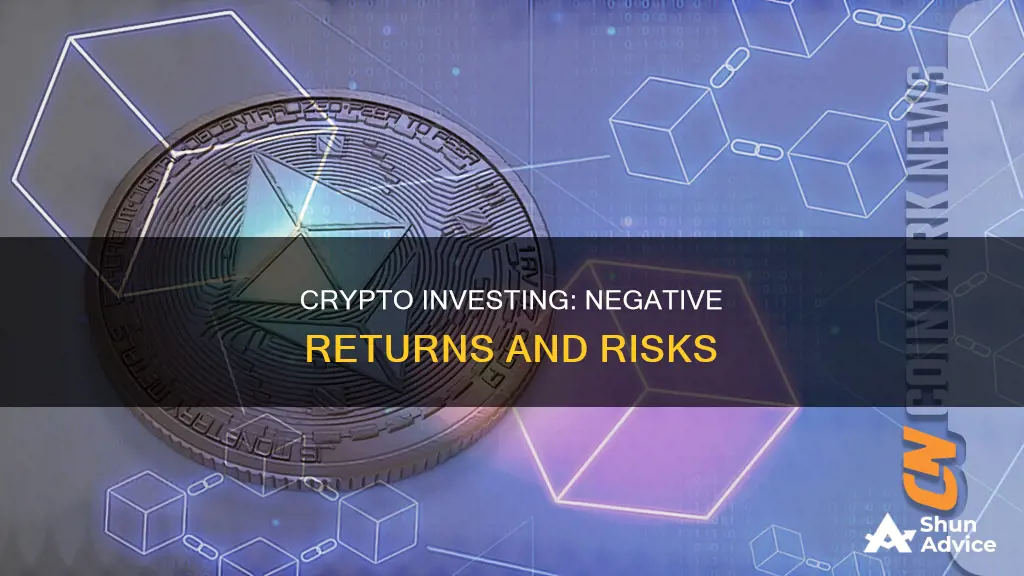
Investing in crypto is risky. The value of cryptocurrencies is volatile and subject to sharp declines at any time. If demand weakens, prices can plummet. Cryptocurrencies are not backed by tangible assets, nor are they regulated by governments or financial institutions. If people lose faith in them, their value can quickly drop to zero.
However, it is not possible for crypto to go below zero into a negative balance. The lowest price crypto can ever reach is $0. While you can lose all your money if a cryptocurrency crashes, you cannot go into debt from investing in crypto alone.
That said, there are ways to lose more than your initial investment. For example, if you use leverage or margin trading, you could lose more than your invested amount. Additionally, if you use a platform like Coinbase, a negative balance can occur if your bank or card issuer declines a transfer after Coinbase has credited the deposited amount to your account.
| Characteristics | Values |
|---|---|
| Can crypto go negative? | No, the value of a cryptocurrency cannot be worth less than $0. |
| Can you lose more than your investment in crypto? | Yes, if you use strategies like margin trading or futures contracts. |
| Can you lose your crypto investment? | Yes, if you lose your security keys or if the blockchain gets hacked. |
| Can you go into debt from investing in crypto? | Yes, if a purchase of crypto or a deposit of cash into your account is not successfully paid by your bank or card issuer. |
What You'll Learn
- The value of a cryptocurrency cannot go below $0
- You can lose more than you invest in crypto if you use leverage
- A negative balance can occur when a purchase of crypto is not successfully paid by your bank
- If you lose your security keys, you lose your tokens
- You can lose money in crypto due to human error

The value of a cryptocurrency cannot go below $0
Cryptocurrency is a digital asset, and while it faces a lot of adoption and regulation issues, it works just like other assets such as real estate. All coins start at $0.00, and their value is based on market demand. When most investors and traders express interest and invest in a cryptocurrency, it gains in value. When people lose interest, its value can crash.
Cryptocurrency is a volatile investment, and its value can fluctuate wildly. If demand for a particular cryptocurrency falls, the price will follow. This can lead to big losses for investors. A few things can cause demand to drop, such as negative news about the currency, changes in the market, or a lack of interest from buyers.
While the value of a cryptocurrency cannot go negative, an investor's account can end up in the red if they don't fully understand the risks of this fast-moving market. For example, if the price of a cryptocurrency drops below a certain level, mining will become unprofitable, and miners will shut down their operations. This would cause the supply of that cryptocurrency to decrease, leading to even higher prices when demand increases again.
Additionally, if you buy cryptocurrency using a bank account or debit card, and your bank reverses or declines the transfer, a negative balance can occur. In this case, the platform may place a hold on your account until you pay the owed balance.
It's important to remember that investing in cryptocurrency is high risk. The value of a cryptocurrency cannot go negative, but it can drop to $0, making it worthless.
Nav Coin: A Smart Investment Decision?
You may want to see also

You can lose more than you invest in crypto if you use leverage
It is important to note that the value of a cryptocurrency cannot be worth less than $0. The lowest price crypto can ever reach is $0. However, that does not mean that investors are completely protected from losses.
The crypto market is volatile and it is possible for investors to lose considerable amounts of money, especially if they use higher-risk strategies such as short selling and margin trading. These strategies can potentially result in significant losses as well as gains.
If you use leverage, you can lose more than you invest in crypto. Leverage means borrowing money from a broker to invest more than you otherwise could. As a result, you can boost your earnings, but are also at risk of losing more if the market goes the other way. For example, if you borrow money to buy $15,000 worth of crypto and the price crashes, you will have to sell a significant portion of your holdings to cover the cost of the loan. In this case, your losses will be greater than your initial investment.
Another way to lose more than you invest is by investing with credit. If you buy crypto with a credit card and the price of crypto crashes, you will still have to pay any interest charges on the credit card.
Therefore, it is important to only invest what you can afford to lose and to avoid investing techniques you don't understand, such as margin trading.
Tom Brady's Bitcoin Investment: Did He Make the Right Move?
You may want to see also

A negative balance can occur when a purchase of crypto is not successfully paid by your bank
- Your bank reversing the purchase, resulting in no credit being added to your account, and the cash value being returned to your bank.
- Issues with your card issuer, leading to a failed payment.
- In some cases, the negative balance may be due to duplicate entries in your transaction history. This usually occurs when you manually add data for an exchange connection that already has existing connections.
To resolve a negative balance, you can make a payment using a linked bank account or your digital wallet. It is important to address negative balances promptly to avoid further issues, such as restrictions on buying, selling, or trading until the owed balance is paid.
Why Bitconnect is a Better Investment than Bitcoin
You may want to see also

If you lose your security keys, you lose your tokens
Losing your security keys can be a stressful event, especially if you have not prepared for it. If you lose your security keys, you lose access to your crypto wallet and the tokens inside. However, all is not lost. There are steps you can take to mitigate the damage and even prevent the loss of your tokens.
Firstly, it is important to understand the nature of blockchain wallets and their keys. A blockchain wallet is made up of a private key and a public key derived from the private key. The public key is what you give to others so they can send you coins or tokens. The public address is visible to others when transactions are made, but there is no direct identity tied to this address. The assets in your wallet are stored on the blockchain in a public ledger, which means you can have multiple installations of the same wallet on different devices. This also makes it easy to restore a wallet, assuming you have the private key.
The private key is essential to signing transactions and keeping your funds secure. It should be kept private and stored safely, preferably offline on a piece of paper, in a safe, or a bank box. If you lose your private key, there is no way to recover or regenerate it. However, there are other ways to import your wallet address and recover the tokens inside.
One way to do this is through a mnemonic, seed, or recovery phrase. This is an ordered list of random words given to you when you create a wallet address. Keeping a backup of this phrase can help you access and import your wallet address easily. Additionally, you can use a password you set to further protect your wallet. If you have neither the private key nor the recovery phrase, you may not be able to access your wallet again.
To prevent the loss of your tokens, it is crucial to have multiple forms of two-factor authentication (2FA) enabled on your accounts. This could include backup codes, trusted phone numbers, or account recovery contacts. Having a backup of your private key or recovery phrase stored separately from your device can also help. You can also use a different wallet provider by giving them your private key, as all wallets interact with the same system.
In summary, losing your security keys can be a challenging situation, but with proper preparation and backup measures, you can minimize the risk of losing your tokens and maintain access to your crypto wallet.
Crypto Investment: Good or Bad Timing?
You may want to see also

You can lose money in crypto due to human error
It's important to remember that investing in crypto is a high-risk endeavour. While the value of cryptocurrencies can never go negative, you can still lose money in several ways, including through human error.
Human error in the context of cryptocurrencies can lead to losses in a variety of ways. One of the most common mistakes is incorrect cost-basis calculations. Crypto investors need to be cautious when calculating the cost basis of their assets, considering the timing of their initial acquisition and subsequent trades. Another common mistake is incorrect spreadsheet formulas, which can lead to significant losses, as seen in the case of TransAlta.
Incorrect labelling of transactions and accounts is another issue. The complex nature of different blockchains and encryption information makes it easy to mislabel transactions, leading to tedious tax questions and management issues. Security is also a concern, as human error can leave crypto assets vulnerable to cyber threats. Clicking unfamiliar links, opening unknown attachments, and sharing private information outside of secure networks can compromise the security of crypto wallets.
Additionally, bad calculations based on inaccurate exchange fees can occur when relying on data from a single exchange to make calculations about another. This can lead to a chain of crypto accounting errors that are time-consuming and challenging to correct.
To summarise, while the value of cryptocurrencies cannot go negative, human error can lead to significant financial losses. From incorrect calculations and labelling to security breaches, investors need to be vigilant and utilise technology to minimise the impact of human mistakes in the complex world of crypto accounting.
Bitcoin Investment: How Much Should You Put In?
You may want to see also
Frequently asked questions
No, the value of a cryptocurrency cannot be worth less than $0. The lowest price crypto can ever reach is $0.
Yes, you can lose more than your investment in margin trading. If you use leverage, you can lose more than your initial investment.
If a cryptocurrency you own crashes to zero while you still hold it, you will lose all your money unless it manages to rally again. However, you do not owe money to a cryptocurrency that has crashed.
Cryptocurrencies' values depend on the rule of demand and supply. The more popular a coin becomes, the higher its value rises. If people lose faith in a cryptocurrency and begin to sell, it causes the crypto to nosedive.
To prevent losing money when investing in cryptocurrency, you should have a sound investment strategy, stay on top of the news, be strategic and less emotional in your decision-making, avoid FOMO buying and panic selling, and store your crypto in cold offline storage.







